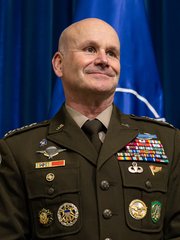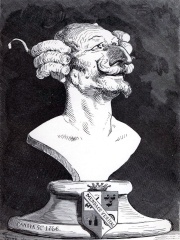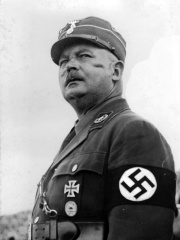
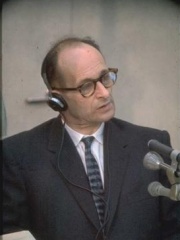
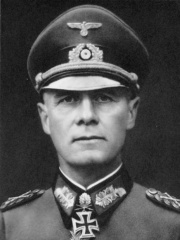
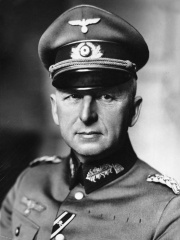
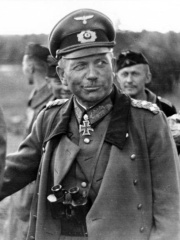
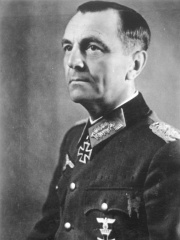
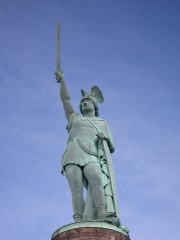
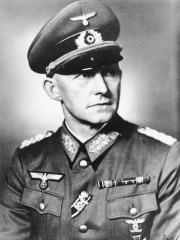
The Most Famous
MILITARY PERSONNELS from Germany
This page contains a list of the greatest German Military Personnels. The pantheon dataset contains 2,058 Military Personnels, 311 of which were born in Germany. This makes Germany the birth place of the most number of Military Personnels.
Top 10
The following people are considered by Pantheon to be the top 10 most legendary German Military Personnels of all time. This list of famous German Military Personnels is sorted by HPI (Historical Popularity Index), a metric that aggregates information on a biography's online popularity. Visit the rankings page to view the entire list of German Military Personnels.

1. Karl Dönitz (1891 - 1980)
With an HPI of 84.90, Karl Dönitz is the most famous German Military Personnel. His biography has been translated into 78 different languages on wikipedia.
Karl Dönitz (German: [ˈdøːnɪts] ; 16 September 1891 – 24 December 1980) was a German naval officer and politician who, following the suicide of Adolf Hitler during the Second World War in April 1945, succeeded him as head of state of Germany during the Nazi era. He held the position until the dissolution of the Flensburg Government following Germany's unconditional surrender to the Allies weeks later. As Supreme Commander of the Navy beginning in 1943, he played a major role in the naval history of the war. He began his career in the Imperial German Navy before the First World War. In 1918 he was commanding UB-68, and was captured as a prisoner of war by British forces. As commander of UB-68, he attacked a convoy in the Mediterranean while on patrol near Malta. Sinking one ship before the rest of the convoy outran his U-boat, Dönitz began to formulate the concept of U-boats operating in attack groups Rudeltaktik (German for "pack tactic", commonly called a "wolfpack") for greater efficiency, rather than operating independently. By the start of the Second World War, Dönitz was supreme commander of the Kriegsmarine's U-boat arm (Befehlshaber der U-Boote [BdU]). In January 1943 he achieved the rank of Großadmiral (grand admiral) and replaced Grand Admiral Erich Raeder as Commander-in-Chief of the Navy. He was the main enemy of Allied naval forces in the Battle of the Atlantic. From 1939 to 1943 the U-boats fought effectively but lost the initiative from May 1943. He ordered his submarines into battle until 1945 to relieve the pressure on other branches of the Wehrmacht (armed forces). 648 U-boats were lost—429 with no survivors. Furthermore, of these, 215 were lost on their first patrol. Around 30,000 of the 40,000 men who served in U-boats perished. On 30 April 1945, following the suicide of Adolf Hitler and in accordance with his last will and testament, Dönitz was named Hitler's successor as head of state in what became known as the Goebbels cabinet after his second-in-command, Joseph Goebbels, until Goebbels's suicide led to Dönitz's cabinet being reformed into the Flensburg Government instead. On 7 May 1945, he ordered Alfred Jodl, Chief of Operations Staff of the Armed Forces High Command (German: Oberkommando der Wehrmacht (OKW)), to sign the German Instrument of Surrender in Reims, France, formally ending the War in Europe. Dönitz remained as head of state with the titles of President of Germany and Supreme Commander of the Armed Forces until his cabinet was dissolved by the Allied powers on 23 May de facto and on 5 June de jure. By his own admission, Dönitz was a dedicated Nazi and supporter of Hitler. Following the war, he was indicted as a major war criminal at the Nuremberg trials on three counts: conspiracy to commit crimes against peace, war crimes, and crimes against humanity; planning, initiating, and waging wars of aggression; and crimes against the laws of war. He was found not guilty of committing crimes against humanity, but guilty of committing crimes against peace and war crimes against the laws of war. He was sentenced to ten years' imprisonment; following his release, he lived in a village near Hamburg until his death in late December 1980.

2. Adolf Eichmann (1906 - 1962)
With an HPI of 83.12, Adolf Eichmann is the 2nd most famous German Military Personnel. His biography has been translated into 76 different languages.
Otto Adolf Eichmann ( EYEKH-mən; German pronunciation: [ˈʔɔto ˈʔaːdɔlf ˈʔaɪçman] ; 19 March 1906 – 1 June 1962) was a German-Austrian official of the Nazi Party, an officer of the Schutzstaffel (SS), a convicted war criminal, and one of the major organisers of the Holocaust. He participated in the January 1942 Wannsee Conference, at which the implementation of the genocidal Final Solution to the Jewish Question was planned. Following this, he was tasked by SS-Obergruppenführer Reinhard Heydrich with facilitating and managing the logistics involved in the mass deportation of millions of Jews to Nazi ghettos and Nazi extermination camps across German-occupied Europe. He was captured and detained by the Allies in 1945, but escaped and eventually settled in Argentina. In May 1960, he was tracked down and apprehended by Israel's Mossad intelligence agency, and put on trial before the Supreme Court of Israel. The highly publicised Eichmann trial resulted in his conviction in Jerusalem, following which he was executed by hanging in 1962. After doing poorly in school, Eichmann briefly worked for his father's mining company in Austria, where the family had moved in 1914. He worked as a travelling oil salesman beginning in 1927, and joined both the Nazi Party and the SS in 1932. He returned to Germany in 1933, where he joined the Sicherheitsdienst (SD, "Security Service"); there he was appointed head of the department responsible for Jewish affairs – especially emigration, which the Nazis encouraged through violence and economic pressure. After the outbreak of the Second World War in September 1939, Eichmann and his staff arranged for Jews to be concentrated in ghettos in major cities with the expectation that they would be transported either farther east or overseas. He also drew up plans for a Jewish reservation, first at Nisko in southeast Poland and later in Madagascar, but neither of these plans were carried out. The Nazis began the invasion of the Soviet Union on 22 June 1941, and their Jewish policy changed from internment or coerced emigration to extermination. To coordinate planning for the genocide, Eichmann's superior Reinhard Heydrich hosted the regime's administrative leaders at the Wannsee Conference on 20 January 1942. Eichmann collected information for him, attended the conference, and prepared the minutes. Eichmann and his staff became responsible for Jewish deportations to extermination camps, where the victims were gassed. After Germany occupied Hungary in March 1944, Eichmann oversaw the deportation of much of the Jewish population. By the time the transports were stopped in July 1944, 437,000 of Hungary's 725,000 Jews had been deported. Most of the victims were sent to Auschwitz concentration camp, where about 75 per cent were murdered upon arrival. Dieter Wisliceny testified at Nuremberg that Eichmann told him he would "leap laughing into the grave because the feeling that he had five million people on his conscience would be for him a source of extraordinary satisfaction". After Germany's defeat in 1945, Eichmann was captured by US forces, but he escaped from a detention camp and moved around Germany to avoid recapture. He ended up in a small village in Lower Saxony, where he lived until 1950 when he moved to Argentina using false papers he obtained with help from an organisation directed by Catholic bishop Alois Hudal. Information collected by Mossad, Israel's intelligence agency, confirmed his location in 1960. A team of Mossad and Shin Bet agents captured Eichmann and brought him to Israel to stand trial on 15 criminal charges, including war crimes, crimes against humanity, and crimes against the Jewish people. During the trial, he did not deny the Holocaust or his role in organising it, but said he was simply following orders in a totalitarian Führerprinzip system. He was found guilty on all of the charges, and was executed by hanging on 1 June 1962. The trial was widely followed in the media and was later the subject of several books, including Hannah Arendt's Eichmann in Jerusalem, in which Arendt coined the phrase "the banality of evil" to describe Eichmann.

3. Erwin Rommel (1891 - 1944)
With an HPI of 82.62, Erwin Rommel is the 3rd most famous German Military Personnel. His biography has been translated into 88 different languages.
Johannes Erwin Eugen Rommel (pronounced [ˈɛɐviːn ˈʁɔməl] ; 15 November 1891 – 14 October 1944), known as The Desert Fox (German: Wüstenfuchs, pronounced [ˈvyːstn̩ˌfʊks] ), was a German Generalfeldmarschall (field marshal) during World War II. He served in the Wehrmacht of Nazi Germany, as well as in the Reichswehr of the Weimar Republic, and Imperial German Army of the German Empire. Rommel was a highly decorated officer in World War I and awarded the Pour le Mérite for his actions on the Italian Front. In 1937, he published his classic book on military tactics, Infantry Attacks, drawing on his experiences in that war. In World War II, he commanded the 7th Panzer Division during the 1940 invasion of France. His leadership of German and Italian forces in the North African campaign established his reputation as one of the ablest tank commanders of the war, and earned him the nickname der Wüstenfuchs, "the Desert Fox". Among his British adversaries he had a reputation for chivalry, and his phrase "war without hate" has been uncritically used to describe the North African campaign. Other historians have rejected the phrase as a myth, citing crimes against North African Jewish populations. Others note there is no clear evidence Rommel was involved in or aware of these crimes. He later commanded the German forces opposing the Allied cross-channel invasion of Normandy in June 1944. After the Nazis gained power, Rommel pledged allegiance to the new regime. However, historians have given different accounts of the specific period and his motivations. At least until near the war's end, he was a loyal supporter of Adolf Hitler, but not to the Nazi party and SS. In 1944, Rommel was implicated in the 20 July plot to assassinate Hitler. Subsequently, Rommel was given a choice between suicide or facing a trial that would result in his disgrace and execution. He ultimately chose the former and took a cyanide pill. Rommel was given a state funeral, and it was announced he had succumbed to injuries from the strafing of his car in Normandy. He is considered the most well-known general on any side of World War II, with his actions in the war still attracting major attention until this day. Rommel became a larger-than-life figure in Allied and Nazi propaganda, and in postwar popular culture. Numerous authors portray him as an apolitical, brilliant commander and a victim of Nazi Germany, although others have contested this assessment and called it the "Rommel myth". Rommel's reputation for conducting a clean war was used in the interest of the West German rearmament and reconciliation between the former enemies – the UK and the US on one side and the new Federal Republic of Germany on the other. Several of Rommel's former subordinates, notably his chief of staff Hans Speidel, played key roles in German rearmament and integration into NATO in the postwar era. The German Army's largest military base, the Field Marshal Rommel Barracks, Augustdorf, and a third ship of the Lütjens-class destroyer of the German Navy are both named in his honour. His son Manfred Rommel was the longtime mayor of Stuttgart, Germany and namesake of Stuttgart Airport.

4. Erich von Manstein (1887 - 1973)
With an HPI of 80.50, Erich von Manstein is the 4th most famous German Military Personnel. His biography has been translated into 58 different languages.
Fritz Erich Georg Eduard von Manstein (born Fritz Erich Georg Eduard von Lewinski; 24 November 1887 – 9 June 1973) was a German military officer who served as a Generalfeldmarschall (Field Marshal) in the Heer (Army) of Nazi Germany during World War II. He was subsequently convicted of war crimes and sentenced to 18 years' imprisonment. Born into an aristocratic Prussian family with a long history of military service, Manstein joined the army at a young age and saw service on both the Western and Eastern Front during the First World War (1914–18). He rose to the rank of captain by the end of the war and was active in the inter-war period helping Germany rebuild its armed forces. In September 1939, during the invasion of Poland at the beginning of the Second World War, he served as Chief of Staff to Gerd von Rundstedt's Army Group South. Adolf Hitler chose Manstein's strategy for the invasion of France of May 1940, a plan later refined by Franz Halder and other members of the OKH. Anticipating a firm Allied reaction, should the main thrust of the invasion take place through the Netherlands, Manstein devised an innovative operation to invade France – later known as the Sichelschnitt ("sickle cut") – that called for an attack through the woods of the Ardennes and a rapid drive to the English Channel, thus cutting off the French and Allied armies in Belgium and Flanders. Attaining the rank of general at the end of the campaign, he was active in the invasion of the Soviet Union in June 1941. He led the Axis forces in the siege of Sevastopol (1941–1942) and the Battle of the Kerch Peninsula, and was promoted to field marshal on 1 July 1942, after which he participated in the siege of Leningrad. In December 1942, during the catastrophic Battle of Stalingrad, Manstein commanded a failed relief effort ("Operation Winter Storm"). Later known as the "backhand blow", Manstein's counteroffensive in the Third Battle of Kharkov (February–March 1943) regained substantial territory and resulted in the destruction of three Soviet armies and the retreat of three others. He was one of the primary commanders at the Battle of Kursk (July–August 1943). His ongoing disagreements with Hitler over the conduct of the war led to his dismissal in March 1944. He never obtained another command and was taken prisoner by the British in August 1945, three months after Germany's defeat. Manstein gave testimony at the main Nuremberg trials of war criminals in August 1946, and prepared a paper that, along with his later memoirs, helped cultivate the myth of the clean Wehrmacht – the myth that the German armed forces were not culpable for the atrocities of the Holocaust. In 1949 he was tried in Hamburg for war crimes and was convicted on nine of seventeen counts, including the poor treatment of prisoners of war and failing to protect civilian lives in his sphere of operations. His sentence of eighteen years in prison was later reduced to twelve, and he served only four years before being released in 1953. As a military advisor to the West German government in the mid-1950s, he helped re-establish the armed forces. His memoir, Verlorene Siege (1955), translated into English as Lost Victories, was highly critical of Hitler's leadership, and dealt with only the military aspects of the war, ignoring its political and ethical contexts. Manstein died near Munich in 1973.
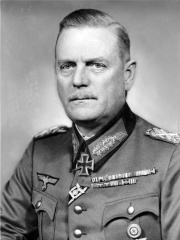
5. Wilhelm Keitel (1882 - 1946)
With an HPI of 80.29, Wilhelm Keitel is the 5th most famous German Military Personnel. His biography has been translated into 64 different languages.
Wilhelm Bodewin Johann Gustav Keitel (German pronunciation: [ˈvɪlhɛlm ˈkaɪtl̩]; 22 September 1882 – 16 October 1946) was a German field marshal who held office as chief of the Oberkommando der Wehrmacht (OKW), the high command of Nazi Germany's armed forces, during World War II. He signed a number of criminal orders and directives that led to numerous war crimes. Keitel's rise to the Wehrmacht high command began with his appointment as the head of the Armed Forces Office at the Reich Ministry of War in 1935. Having taken command of the Wehrmacht in 1938, Adolf Hitler replaced the ministry with the OKW and Keitel became its chief. He was reviled among his military colleagues as Hitler's habitual "yes-man". After the war, Keitel was indicted by the International Military Tribunal in Nuremberg as one of the "major war criminals". He was found guilty on all counts of the indictment: crimes against humanity, crimes against peace, criminal conspiracy, and war crimes. He was sentenced to death and executed by hanging in 1946.

6. Heinz Guderian (1888 - 1954)
With an HPI of 80.22, Heinz Guderian is the 6th most famous German Military Personnel. His biography has been translated into 61 different languages.
Heinz Wilhelm Guderian (German: [haɪnts ˈvɪlhɛlm ɡuˈdeːʁi.an]; 17 June 1888 – 14 May 1954) was a German general in the Heer Army controlled by Nazi Germany’s Wehrmacht and chief of staff in the OKH during World War II who later became a successful memoirist. A pioneer and advocate of the "blitzkrieg" approach, he played a central role in the development of the panzer division concept. After serving in the military since leaving school, including in World War I, in 1936, he was promoted to Heer Generalmajor (Major General) and became the Inspector of Motorized Troops. At the beginning of World War II, Guderian led an armoured corps in the Invasion of Poland with the rank of General der Panzertruppe . During the Invasion of France, he commanded the armoured units that attacked through the Ardennes forest and overwhelmed the Allied defenses at the Battle of Sedan. He led the 2nd Panzer Army with the rank of Generaloberst (Colonel General) during Operation Barbarossa, the invasion of the Soviet Union. The campaign ended in failure after the German offensive Operation Typhoon failed to capture Moscow, and after a disagreement with Hitler, Guderian was dismissed. In early 1943, Adolf Hitler appointed Guderian to the newly created position of Inspector General of Armoured Troops. In this role, he had broad responsibility to rebuild and train new panzer forces but saw limited success due to Germany's worsening war economy. Guderian was appointed Acting Chief of the General Staff of the Army High Command, immediately following the 20 July Plot to assassinate Hitler. Guderian was appointed as a member of the "Court of Honour" by Hitler, which in the aftermath of the plot was used to dismiss people from the military so they could be tried in the "People's Court" and executed. He was Hitler's personal advisor on the Eastern Front and became closely associated with the Nazis. Guderian's troops carried out the criminal Commissar Order during Barbarossa, and he was implicated in the commission of reprisals after the Warsaw Uprising of 1944. Guderian surrendered to US forces on 10 May 1945 and was interned until 1948. He was released without being charged and retired to write his memoirs. Entitled "Memoirs of a Soldier", the autobiography was published in 1950 and became a bestseller. Guderian's writings received backlash in the decades since their release, with historians finding the original works to contain post-war myths, including that of the "clean Wehrmacht". Guderian portrayed himself as the sole originator of the panzer force and refused the stipulation that units under his command committed crimes of war. These criticisms were partially addressed in his 1952 re-release edition of the book, newly entitled Panzer Leader, which mended some historic inaccuracies and introduced a foreword from B. H. Liddell Hart. Guderian died in 1954 and was buried in Goslar.

7. Friedrich Paulus (1890 - 1957)
With an HPI of 80.08, Friedrich Paulus is the 7th most famous German Military Personnel. His biography has been translated into 61 different languages.
Friedrich Wilhelm Ernst Paulus (23 September 1890 – 1 February 1957) was a German Generalfeldmarschall (Field Marshal) during World War II who is best known for his surrender of the German 6th Army during the Battle of Stalingrad (July 1942 to February 1943). The battle ended in disaster for the Wehrmacht when Soviet forces encircled the Germans within the city, leading to the ultimate death or capture of most of the 265,000-strong 6th Army, their Axis allies, and collaborators. Paulus fought in World War I and saw action in France and the Balkans. He was considered a promising officer; by the time World War II broke out, he had been promoted to major general. Paulus took part in the invasions of Poland and the Low Countries, after which he was named deputy chief of the German Army General Staff. In that capacity, Paulus helped plan the invasion of the Soviet Union. In 1942, Paulus was given command of the 6th Army. He led the drive to Stalingrad but was cut off and surrounded in the subsequent Soviet counter-offensive. Adolf Hitler prohibited attempts to break out or capitulate, and the German defense was gradually worn down. Paulus surrendered in Stalingrad on 31 January 1943, the same day on which he was informed of his promotion to field marshal by Hitler. Hitler expected Paulus to take his own life, repeating to his staff that there was no precedent of a German field marshal being captured alive. While in Soviet captivity during the war, Paulus became a vocal critic of the Nazi regime and joined the Soviet-sponsored National Committee for a Free Germany. In 1953, Paulus moved to East Germany, where he worked in military history research. He lived out the rest of his life in Dresden.

8. Arminius (17 BC - 21)
With an HPI of 79.71, Arminius is the 8th most famous German Military Personnel. His biography has been translated into 73 different languages.
Arminius (; 18/17 BC–AD 21; Hermann in German) was a chieftain of the Germanic Cherusci tribe who is best known for commanding an alliance of Germanic tribes at the Battle of the Teutoburg Forest in AD 9, in which three Roman legions under the command of general and governor Publius Quinctilius Varus were destroyed. His victory at Teutoburg Forest precipitated the Roman Empire's permanent strategic withdrawal and the deprovincialization of Germania Magna, and modern historians regard it as one of Imperial Rome's greatest defeats. As it prevented the Romanization of Germanic peoples east of the Rhine, it has also been considered one of the most decisive battles in history and a turning point in human history. Born a prince of the Cherusci tribe, Arminius was part of the Roman-friendly faction of the tribe. He learned Latin and served in the Roman military, which gained him Roman citizenship, and the rank of eques. After serving with distinction in the Great Illyrian Revolt, he was sent to Germania to aid the local governor Publius Quinctilius Varus in completing the Roman conquest of the Germanic tribes. While in this capacity, Arminius secretly plotted a Germanic revolt against Roman rule, which culminated in the ambush and destruction of three Roman legions in the Teutoburg Forest. In the aftermath of the battle, Arminius fought retaliatory invasions by the Roman general Germanicus in the battles of Pontes Longi, Idistaviso, and the Angrivarian Wall, and defeated a rival, the Marcomanni king Maroboduus. Arminius sought to become a king and was assassinated in 21. He was remembered in Germanic legends for generations afterwards. The Roman historian Tacitus designated Arminius as the liberator of the Germanic tribes and commended him for having fought the Roman Empire to a standstill at the peak of its power. During the unification of Germany in the 19th century, Arminius was hailed by German nationalists as a symbol of German unity and freedom. Following World War II, however, Arminius' significance diminished in Germany due to the rise of anti-militarism, pacifism, and anti-nationalism; the 2,000th anniversary of his victory at the Teutoburg Forest was only lightly commemorated in Germany.

9. Alfred Jodl (1890 - 1946)
With an HPI of 78.19, Alfred Jodl is the 9th most famous German Military Personnel. His biography has been translated into 61 different languages.
Alfred Josef Ferdinand Jodl (German: [ˈjoːdl̩] ; born Alfred Josef Baumgärtler; 10 May 1890 – 16 October 1946) was a German military officer who served as the Chief of the Operations Staff of the Oberkommando der Wehrmacht – the German Armed Forces High Command – throughout World War II. After the war, Jodl was indicted on charges of conspiracy to commit crimes against peace, planning, initiating and waging wars of aggression, war crimes, and crimes against humanity at the Allied-organized Nuremberg trials. The principal charges against him related to his signing of the criminal Commando and Commissar Orders. Found guilty on all charges, he was sentenced to death and executed in Nuremberg in 1946.
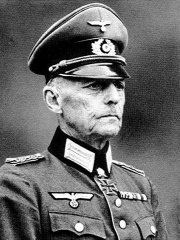
10. Gerd von Rundstedt (1875 - 1953)
With an HPI of 77.61, Gerd von Rundstedt is the 10th most famous German Military Personnel. His biography has been translated into 54 different languages.
Karl Rudolf Gerd von Rundstedt (12 December 1875 – 24 February 1953) was a German Generalfeldmarschall (Field Marshal) in the Heer (Army) of Nazi Germany and Oberbefehlshaber West (Commander-in-Chief in the West) during World War II. At the end of the war, aged 69, with over 52 years of service, he was the Army's most senior officer. Born into a Prussian family with a long military tradition, Rundstedt entered the Prussian Army in 1892. During World War I, he served mainly as a staff officer. In the interwar period, he continued his military career, reaching the rank of Generaloberst (Colonel General) before retiring in 1938. He was recalled at the beginning of World War II as commander of Army Group South in the invasion of Poland. He commanded Army Group A during the Battle of France, and requested the Halt Order during the Battle of Dunkirk. He was promoted to the rank of Field Marshal in 1940. In the invasion of the Soviet Union, he commanded Army Group South, responsible for the largest encirclement in history, the Battle of Kiev. He was relieved of command in December 1941 after authorizing the withdrawal from Rostov but was recalled in 1942 and appointed Commander-in-Chief in the West. He was dismissed after the German defeat in Normandy in July 1944 but was again recalled as Commander-in-Chief in the West in September, holding this post until his final dismissal by Adolf Hitler in March 1945. Though aware of the various plots to depose Hitler, Rundstedt neither supported nor reported them. He also served as chairman of the Ehrenhof, a military committee discharging 20 July plotters from the Wehrmacht, so that they could be tried and murdered by the Volksgerichtshof, a show trial. After the war, he was charged with war crimes, but did not face trial due to his age and poor health. He was released in 1949, and died in 1953.
People
Pantheon has 311 people classified as German military personnels born between 17 BC and 1942. Of these 311, 1 (0.32%) of them are still alive today. The most famous living German military personnels include Christopher G. Cavoli. The most famous deceased German military personnels include Karl Dönitz, Adolf Eichmann, and Erwin Rommel. As of April 2024, 1 new German military personnels have been added to Pantheon including Christopher G. Cavoli.
Living German Military Personnels
Go to all RankingsDeceased German Military Personnels
Go to all RankingsKarl Dönitz
1891 - 1980
HPI: 84.90
Adolf Eichmann
1906 - 1962
HPI: 83.12
Erwin Rommel
1891 - 1944
HPI: 82.62
Erich von Manstein
1887 - 1973
HPI: 80.50
Wilhelm Keitel
1882 - 1946
HPI: 80.29
Heinz Guderian
1888 - 1954
HPI: 80.22
Friedrich Paulus
1890 - 1957
HPI: 80.08
Arminius
17 BC - 21
HPI: 79.71
Alfred Jodl
1890 - 1946
HPI: 78.19
Gerd von Rundstedt
1875 - 1953
HPI: 77.61
Baron Munchausen
1720 - 1797
HPI: 77.47
Ernst Röhm
1887 - 1934
HPI: 77.03
Newly Added German Military Personnels (2025)
Go to all RankingsOverlapping Lives
Which Military Personnels were alive at the same time? This visualization shows the lifespans of the 25 most globally memorable Military Personnels since 1700.

